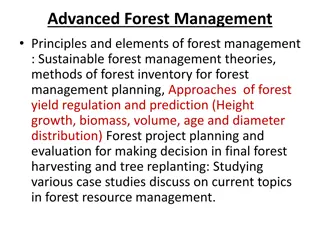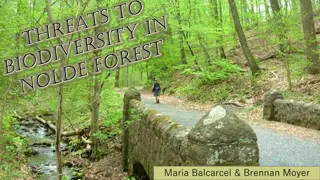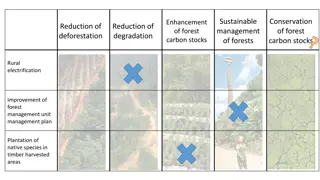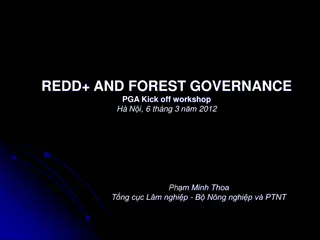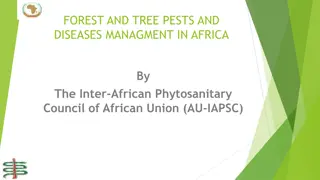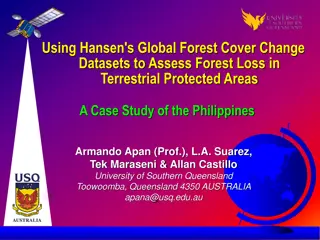Białowieża Forest: Europe's Last Primeval Forest
Białowieża Forest, the largest natural forest complex in the Central European Lowlands, is a treasure trove of diverse forest communities and abundant wildlife. Protected since ancient times, it faces threats like the European spruce bark beetle. Ecologists advocate for forest conservation to preserve biodiversity and habitats for rare species.
Download Presentation

Please find below an Image/Link to download the presentation.
The content on the website is provided AS IS for your information and personal use only. It may not be sold, licensed, or shared on other websites without obtaining consent from the author.If you encounter any issues during the download, it is possible that the publisher has removed the file from their server.
You are allowed to download the files provided on this website for personal or commercial use, subject to the condition that they are used lawfully. All files are the property of their respective owners.
The content on the website is provided AS IS for your information and personal use only. It may not be sold, licensed, or shared on other websites without obtaining consent from the author.
E N D
Presentation Transcript
The largest in the Central European Lowlands natural forest complex, located in the south-eastern part of the North Podlasie Lowland and Belarus, in the main basin of the Narew and Jasio dy; area of approx. 1,460 km2, of which the Polish borders over 580 km2; Bialowieza Forest represent different forest communities; among the many different kinds of stands they have a large share of spruce, pine, alder, birch, oak; prevailing forest types: mixed forest, fresh mixed coniferous forest fresh, moist forest; ols appropriate and ash and riverine; great wealth undergrowth and undergrowth; Many animal species (m.in .: bison, elk, deer, roe deer, wild boar, lynx, wolf, badger, beaver, grouse, crane); reserves bison breeding and tarpan; most valuable natural object in Poland - Bialowieza National Park.
The last such forest in Europe Bialowieza Forest is the best preserved lowland forest on the continent. Protected as a whole by the Lithuanian princes, Polish kings and Russian tsars then survived almost unchanged until World War I, when German authorities began felling. Still, even outside protected areas, you can see here forest fragments, which centuries ago were covered Europe.
European spruce bark beetle Beetle sizes up to 4.5 mm. It has a cylindrical body. Inhabits standing trees. Mating chamber usually placed in the bark. Pupation between the bark and the wood, less in the bark. The most dangerous secondary pest of spruce. It can also occur on a pine tree. This is one of the biggest pests forest plantations. Foresters catch adults in pheromone traps.
How dangerous is the European spruce bark beetle? European spruce bark beetle feeds on the wood under the bark of trees and brings them to death, even within one month. Normally insect attacks trees old or weakened. But this time the gradation is so great that it suffered the tree young, healthy and strong. You also have to remember that the European spruce bark beetle in the forest began to attack already other species, for example. Pine and larch. European spruce bark beetle feeds on the wood under the bark of trees and brings them to death, even within one month. Normally insect attacks trees old or weakened. But this time the gradation is so great that it suffered the tree young, healthy and strong. You also have to remember that the European spruce bark beetle in the forest began to attack already other species, for example. Pine and larch.
ECOLOGISTS Ecologists think that cutting out and removing dying spruces lose, among other things: 1. A chance for a more effective, faster, natural and biologically diverse forest regeneration of the forces of nature; 2. Place the production and distribution of the "biological weapon" against bark beetles; 3. The only habitat for many species of saproxylic beetles, which is associated with deadwood and dying trees, as well as the subcortical zone occurs in such trees; 4. The most important breeding sites of rare woodpeckers, above all, three- toed woodpecker.
Ecologists also point out that the stretch in Bialowieza, could result in the imposition of severe penalties from the European Commission and pick up the forest status of World Heritage Site.
FORESTERS Foresters explain that their duty is to "maintain the sustainability and continuity of the use of forests as to forests left to future generations were able to at least that in which we found them. Unless better " The duty of foresters is to fight the pest. The Directorate says that in 2015. In the primeval forest districts were inventoried approx. 200 thousands of spruces populated by bark beetles. The total weight of the wood is 260 thousand m3 "As a result there has been a breakdown of the bark beetle gradation forests of spruce, on a total area of over 4 thousands hectares - in such an area does not and will not be for many years lively forest "
IN CONCLUSION... Such a sudden increase in the population of bark beetle not seen in many decades. Its victim fell already half a million trees in three forest districts. At this point the dead is 4,000 with 52,000 stands, which take care of foresters. Ecologists underline, in turn, that stretch can disrupt the ecosystem of the oldest Polish forest. - bark beetle plays a role there. On these trees live rare species for example. Three-toed woodpecker, which population in Poland is very low.
Foresters - against the ecologists - also advocate for active protection of trees, which are destroying by pests. While ecologists are tending to take the whole forest protection passive - such as a national park. Ecologists argue, however, that slice is made in valuable natural and harming nature. Foresters argue that for the good of the forest need to cut spruce trees attacked by the spruce bark beetle. The removal attacked trees is according to them, the only way to stop the invasion of insects. Ecologists are sounding the alarm and say that nature itself can handle.
Foresters explain plans for cuts need to reduce the huge gradation of bark beetle, which in the past three years has killed spruce trees with a weight of approx. 500 thousand. m3 approx. 4 thousand. hectares. Ecologists want the Forest developed in a natural way, so naturally Forest will soon die. They remain after the only weeds, hazel and birch, which does not bode for the future. To save healthy spruce trees, you need to cut out the ones that were attacked by the bark beetle.
Interesting fact... The symbol of the Bialowieza Forest is bison. In this park were saved from extinction of this species. Some thinks that the name ubr wka is from bisons, but the real name comes from grass, also known as "Bison Vodka", " ", "Wisentvodka", "Zubrivka" or "Grasovka".
Thanks for watching! Presentation created by: Natalia Koby t Miros aw Dybowski Kacper Drewniak






